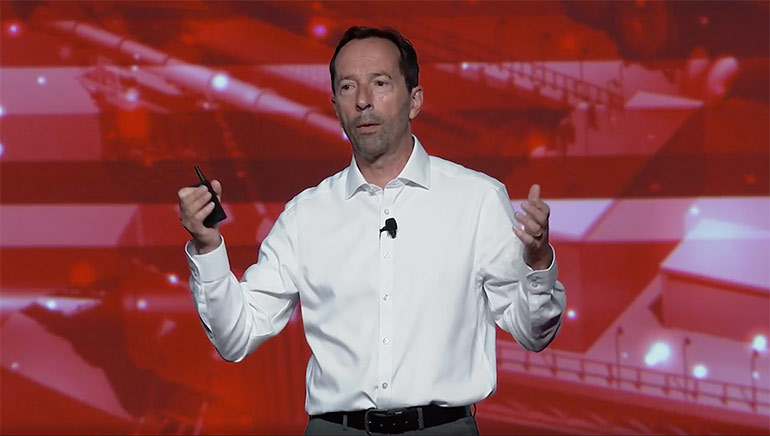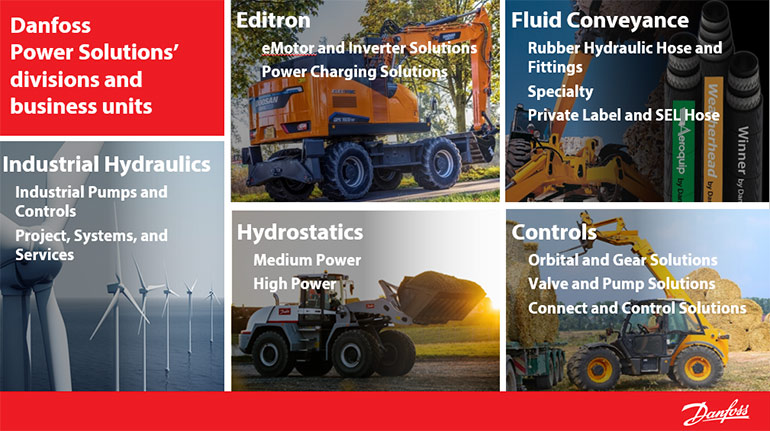At the Danfoss Distributor Meeting in September, Eric Alstrom, president of Danfoss Power Solutions, said the company has seen significant growth with a 50% increase in core business revenues since 2017, but noted there’s still room for improvement in understanding and meeting customer expectations.
He underscored current market challenges, such as economic uncertainties, geopolitical influences, and cyclical industry trends in hydraulics. He emphasized the importance of listening to its customers, particularly OEM and distribution partners, and improving responsiveness to their needs. That’s why Danfoss introduced its new organizational changes, reducing the number of divisions from seven to five and the number of business units from 27 to 12. This includes decentralizing decision-making to divisional leaders, reducing complexity in sales structures, and focusing on regionalizing the supply chain for better responsiveness. Alstrom noted that the move was done to mirror the engineering structures of its customers.

Eric Alstrom, Danfoss Power Solutions CEO
Fluid Power World sat down with Alstrom to discuss how Danfoss Power Solutons is strengthening partnerships with its distribution and OEM customers, enhancing operational efficiency, and preparing for future growth. Read our interview below.
FPW: Earlier this year, you did some restructuring at Danfoss. Let’s talk about the reorganization and how things are going as you continue to bring legacy Eaton and Danfoss together.
Eric Alstrom: Our original plan was to reassess after we came together as a new company, to reassess what’s working and what’s not after a couple of years, and that’s what we started doing earlier this year. In line with that thinking, we also spoke to customers and asked them for feedback on what’s working what’s not. And the feedback was clear and concerning, because whether it was OEM customers or distribution partners, the feedback was consistent that we were just a little bit too complex of an organization. We have too many touch points. That’s why we went down to five divisions instead of seven, and from 27 business units down to 12 to have fewer touch points.
The other reason was that when I started speaking to OEM customers, it became clear that they very rarely have a work function and a controls group. They have an engine team, a structures group, propel group, controls group and maybe a software team, and there is no real work function in that sense. The other products are still relevant, with steering, valves and motors and so forth, gear products and all that, but it seemed redundant to have two teams, since that’s not really aligned with how most of our customers are organized. So that’s what we did.
And then, of course, looking at what’s working and what’s not, we also looked at the size of our workforce, and unfortunately, that’s what led to the conclusion that we needed to downsize a bit. We didn’t do that when we came together as a new company. We had said, you know, the notion was great. We have twice as many salespeople, we have twice as many engineers. We can probably do much more, right? And we did more, but not twice as much. And that’s also why we said, maybe leaning out a little bit will make it also a faster organization.

A breakdown of the new business unit and divisional structure for Danfoss Power Solutions.
FPW: What was the percentage of the of the downsizing?
Eric Alstrom: Very small. We’re talking a couple percentage points. It’s not a significant number per se, but in our culture, any downsizing is painful. We’re not used to it. Since I started, we’ve never done it. Yes, we’ve eliminated some activity because we didn’t want to do something anymore. But apart from that, we have never done a general downsizing like we did this time, and that’s because our notion is to grow the business, grow the company, and that’s what we have done successfully. Now the downturn is a little bit more pronounced and longer than expected.
FPW: That leads to my next question. All the economists and bigger companies like Danfoss have been saying we’re hitting the headwinds. But some of the smaller companies have been saying they haven’t seen it yet. Why do you think Danfoss and some of the bigger companies have seen it sooner?
Eric Alstrom: Our revenue is so largely in off highway. I think some of our distribution partners and some of the companies that are perhaps a little bit smaller in size that you refer to, they may be a little bit more diversified. Off highway equipment is usually very early in a down cycle and early in an up cycle. And that comes because of the nature of our end customers. Our customers are price sensitive. They’re very sensitive to interest rate changes and because much of the machinery is leased, an interest rate in the 6-7% rate makes a huge difference for somebody who has some machines, whether it’s a farmer or a small construction company. They stop buying equipment immediately.
I think it was also an inventory issue that some of the larger distribution partners and the larger OEMs actually were sitting on a fair amount of inventory. And if you look at the end users then being reluctant to buy, large OEMs have had finished machines sitting on dealer lots a lot longer than they used to. Of course, then they also slow things down.
FPW: How do you see the recovery taking shape, and when do you think it’s going to kind of turn around?
Eric Alstrom: Because we keep a good pulse on our customers and how they feel and what they flag in terms of scheduling, we don’t really see a trend change at the moment. We also don’t see that we’re falling off a cliff or that it’s getting worse, which is good, but we still are at a significantly lower level in ‘24 versus what we planned for. We planned for a flat year, and we are in negative growth territory this year, so I think we will see a demand increase during next year.
The difficult question to answer is when. A lot of things are in play that will probably help with that too, instant interest rates being one of them.
FPW: It seems like hose is a big focus for Danfoss. Is that kind of one of the main things that you want to focus on right now, is growing that division?
Eric Alstrom: We have so many cool things coming in all of our product divisions that it’s hard to say that we’re focusing more here rather than there. In fact, I think the answer is that we now see fluid conveyance hose as part of our core, and we’ve always said very clearly that we invest in our core. Electrification is also part of our core. We try to spread our investments across all of our divisions, and all of them are really astute at coming with good business cases. But the answer is, we focus across all our divisions, and nobody’s getting preferential treatment.
FPW: Can you expand upon what’s happening with the regional investments and what lines are being focused on with these facilities?
Eric Alstrom: We have Queretaro, Mexico where we have both what we call PMC which is everything that moves. And we also have fluid conveyance in Queretaro. And these are two absolutely fantastic assets that we got through the acquisition of Eaton Hydraulics. We are focusing on placing new product there. We are launching a number of new products, and we try to then make sure that we do that where we have capacity. There are several other locations, like Japan, which we also got through the acquisition, which is exciting for us, because it’s a lot easier to compete in the Japanese market if you have local manufacturing. There are facilities also in the US that we’re very happy to have, because we’re close to the customers. It’s a full order to invest in all these factories, because perhaps the previous owner didn’t invest quite as much as we would have done. And that’s probably an understatement.
FPW: Speaking of investing where the previous owner didn’t, let’s discuss how the Vickers brand is going.
Eric Alstrom: It’s been a little bit of our dream for us to have that brand, because even though the previous owners didn’t really invest in the industrial portfolio, the brand still has been strong, and it’s still recognized as a leading industrial brand. What we are doing now is trying to put that in the foreground, because that brand recognition brings a value. It’s a value of trust for many of our customers. They know that Vickers always stood for quality, reliability, durability, and that’s exactly how we will keep positioning the brand. We have a rhythm of every six months, there is a new Vickers product coming out to get that brand established again as a leader in the industrial technologies, and I think we’re well underway.
When I speak to our distribution partners, they’re very excited about using the Vickers brand. And it is ‘Vickers by Danfoss,’ and that little ‘by Danfoss’ is also important, because there’s also a great deal of trust in our name, especially the long-term thinking being a family owned company. We have a different horizon than others. We think in generations, not necessarily in quarters.
FPW: Let’s talk about sustainability. Can you give me a little bit of insight into some of the sustainability goals you have?
Eric Alstrom: Part of our mission in life as a company is sustainability. Like I said, we think in generations, we want to make sure that we do our part of making the world a better place for generations to come. We take this very, very seriously. So, if you look at many of our locations today, they are CO2 neutral, like our headquarters in Nordborg, including the factories we have there. Here in the US, we have an agreement with power suppliers that we get green energy to all our locations here. We’ve cut down on perhaps seemingly mundane things, but we’ve stopped using plastic bottles in all our facilities.
We’re doing it with our hearts but also with our minds, because this is also an important business value proposition for many of our customers, that we can supply them with green technologies. You know, in most off-highway machinery, there’s a diesel engine operating, but with our technologies, we can reduce the emissions from those engines. And I get that question often from younger employees that are just joining us from the university, ‘you know, why don’t we stop supplying to diesel engines?’ If we don’t supply to them, they will have higher emissions than if they use Danfoss technology. So, we are investing in electrification. It’s absolutely our job to make sure that we make those applications as green as possible.
FPW: Related to this, it seems like digitalization is the big movement on most of your new products.
Eric Alstrom: Yes, you’re right. Because everything we do is more or less digital. Pretty much everything is connected in the machine. And we are the queens and kings of connectivity in such machines. Our people are the experts. Our distribution partners are the experts for an extended engineering workbench. I’m proud to work for a company like Danfoss that is thinking in terms of sustainability and for generations to come. And we take it very, very seriously.
Filed Under: Featured, Industry News, Trending